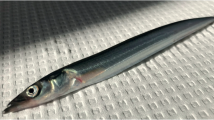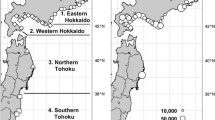Abstract
Annual reproductive cycle, age and body size at maturity, and potential and relative fecundity were examined in female willowy flounder in the North Pacific off Japan. Vitellogenesis became active from September, followed by the beginning of spawning in December. The spawning season continued until May with its peak in January. Estimated maturation rate was 50% at a standard length of 16 cm, 30% in 2-year-olds, and almost 100% in ≥3-year-old fish. Potential fecundity increased with age, while relative fecundity decreased in older fish. The results clarify some aspects of the detailed reproductive biology of female willowy flounder and emphasize the importance of age-composition data in estimating reproductive potential within a population.
Similar content being viewed by others

References
Sakamoto K. Tanakius kitaharai (Jordan et Starks). In: Masuda H, Amaoka K, Araga C, Uyeno T, Yoshino T (eds). The Fishes of the Japanese Archipelago. Tokai University Press. Tokyo, 1984; 339.
Narimatsu Y, Ito M, Hattori T, Fujiwara K. Stock assessment of willowy flounder in the North Pacific Ocean off Japan in 2005. In: Stock Assessment of Fisheries Resources Around Japan. Fisheries Agency of Japan. 2006; 1292–1302 (in Japanese).
Fujita S. Early development and rearing of two common flatfishes, Eopsetta grigorjewi (Herzenstein) and Tanakius kitaharai (Jordan et Starks). Nippon Suisan Gakkaishi 1965; 31: 258–262.
Minami T. The early life history of a flounder Tanakius kitaharai. Nippon Suisan Gakkaishi 1983; 49: 527–532.
Hashimoto R. Studies on the age of Tanakius kitaharae (Jordan & Starks). Bull. Tohoku Reg. Fish. Res. Lab. 1955; 4: 156–164.
Yabuki K. Age determination of yanagimushigarei Tanakius kitaharai (Pleuronectidae) from otoliths in the Sea of Japan off Kyoto Prefecture. Nippon Suisan Gakkaishi 1989; 55: 1331–1338.
Shimamura S, Igarashi S. Flatfish, Tanakius kitaharai (Jordan et Starks) caught in the coast of Fukushima region. Bull. Fukushima Pref. Fish. Exp. Stat. 2000; 9: 29–52.
Yagishita N, Ohki S, Yamazaki A. Age, growth and age composition of Tanakius kitaharat in western Wakasa Bay, Japan, Nippon Suisan Gakkaishi 2005; 71: 138–145.
Ouchi A, Ogata T. Studies on the animal distribution in the abstained areas for trawl-fishery of the northern Japan Sea I. Young bottom fishes. Ann. Rep. Jpn. Sea. Reg. Fish. Res. Lab. 1960; 6: 157–171.
Hunter JR, Macewicz BJ. Measurement of spawning frequency in multiple spawning fishes. NOAA Techn Rep. NMFS. 1985; 36: 79–94.
Yamamoto K. Studies on the formation of fish eggs I. Annual cycle in the development of ovarian eggs in the flounder, Liopsetta obscura. J. Fac. Fish. Hokkaido Univ. 1956; 12: 362–373.
Wallace RA, Selman K. Cellular and dynamic aspects of oocyte growth in teleosts. Am. Zool., 1981; 21: 325–343.
Takano K. Ovarian structure and gametogenesis. In: Takashima F, Hanyu I (eds), Reproductive Biology of Fish and Shellfish. Midori-Shobo, Tokyo. 1989; 3–34 (in Japanese).
Kurita Y. Procedures to estimate reproductive traits of fish by combining field surveys and experiments. Bull. Fish. Res. Agen. Suppl. 2006; 4: 87–99.
De Vlaming VL. Oocyte development patterns and hormonal involvements among teleosts. In: Rankin JC (ed.), Control. Processes in Fish Physiology. Chapman & Hall, London, 1983; 176–199.
Harmin SA, Crim LW, Wiegand MD. Plasma sexsteroid profiles and the seasonal reproductive cycle in male and female winter flounder, Pleuronectes americanus. Mar. Biol. 1995; 121: 601–610.
Janssen PAH, Lambert JGD, Goos HJTh. The annual ovarian cycle and the influence of pollution on vitellogenesis in the flounder, Pleuronectes flesus. J. Fish. Biol. 1995; 47: 509–523.
Maddock DM, Burton MPM. Gross and histological observations of ovarian development and related condition changes in American plaice. J. Fish. Biol. 1999; 53: 928–944.
Narimatsu Y, Kitagawa D, Hattori T, Onodera H. Reproductive biology of female Rikuzen sole (Dexistes rikuzenius). Fish. Bull. 2005; 103: 635–647.
De Vlaming VL. The effects of temperature and photoperiod on reproductive cycling in the estuarine gobiid fish. Gillichthys mirabilis. Fish. Bull. 1972; 70: 1137–1152.
Hanyu I. Reproductive cycle. In: Itazawa H, Hanyu I (eds). Fish Physiology, Koseisha-Koseikaku, Tokyo. 1991; 287–325 (in Japanese).
Hirakawa H, Tominaga A. Annual changes of recruitment in flatfishes in Joban and Kashimanada waters. Bull. Jpn. Soc. Fish. Oceanogr. 1998; 62: 24–25.
Nihira A. The responses of demersal fish populations to climatic regime shifts. Kaiyo Monthly. 2006; 38: 192–199.
Schultz ET, Cliftonet LG, Warner RR. Energetic constraints and size-based tactics: the adaptive significance of breeding schedule variation in a marine fish (Embiotocidae: Micrometrus minimus). Am. Nat. 1991; 138: 1408–1430.
Baylis JR, Wiegmann DD, Hoff MH. Alternating life histories of smallmouth bass. Trans. Am. Fish. Soc. 1993; 122: 500–510.
Schultz ET. The effects of birth date on fitness of female dwarf perch, Micrometrus minimus (Perciformes: Embiotocidae). Evolution 1993; 47: 520–539.
Trippel EA, Kjesbu OS, Solemdal P. Effects of adult age and size structure on reproductive output in marine fishes. In: Chambers C, Trippel EA (eds), Early Life History and Recruitment in Fish Populations. Chapman & Hall, London. 1997; 31–62.
Nakahara T. Fishery and biological characteristics of commercially important demersal fishes inhabited on the continental shelf off Yamaguchi Prefecture. Bull. Yamaguchi Pref. Open-Sea Fish. Exp. Stn. 1969; 11: 1–70.
Igarashi S, Shimamura S. Feeding habits of flatfish, Tanakius kitaharai (Jordan et Starks), in Fukushima. Bull. Fukushima Pref. Fish. Exp. Stat. 2000; 9: 53–58.
Beacham TD. Variability in median size and age at sexual maturity of Atlantic cod (Gadus morhua) on the Scotian Shelf in the Northwest Atlantic Ocean. Fish. Bull. 1983; 81: 303–321.
Jørgensen T. Long-term changes in age at sexual maturity of Northeast Arctic cod (Gadus morhua L.). J. Conserv. Int. Explor. Mer. 1990; 46: 235–248.
Bowering WR, Brodie WB. Distribution of commercial flatfishes in the Newfoundland-Labrador region of the Canadian Northwest Atlantic and changes in certain biological parameters since exploitation. Neth. J. Sea Res. 1991; 27: 407–422.
Trippel EA. Age at maturity as a stress indicator in fisheries. Bioscience 1995; 45: 759–771.
Armstrong MJ, Gerritsen HD, Allen M, McCurdy WJ, Peel JAD. Variability in maturity and growth in a heavily exploited stock: cod (Gadus morhua L.) in the Irish Sea. ICES J. Mar. Sci. 2004; 64: 98–112.
Engelhard GH, Heino M. Maturity changes in Norwegian spring-spawning herring Clupea harengus: compensatory or evolutionary responses? Mar. Ecol. Prog. Ser. 2004; 272: 245–256.
Narimatsu Y. Reproductive biology of Pacific cod, a review especially referring to interannual variations of biomass, age and size at maturity and fecundity. Bull. Fish. Res. Agen. Suppl. 2006; 4: 137–146.
Horwood JW, Bannister RCA, Howlett GJ, Comparative fecundity of North Sea plaice. Proc. R. Soc. Lond. B. 1986; 228: 401–431.
Koslow JA, Bell J, Virtue P, Smith DC. Fecundity and its variability in orange roughy: effects of population density, condition, egg size, and senescence. J. Fish. Biol. 1995; 47: 1063–1080.
Beverton RJH, Holt SJ. On the dynamics of exploited fish populations. Fish. Invest. Ser. II. 1957; 29: 1–553.
Beverton RJH, Hylen A, Østedt OJ. Growth, maturation, and longevity of maturation cohorts of Northeast Arctic cod. ICES Mar. Sci. Symposia. 1994; 198: 482–501.
Murawski SA, Rago RJ, Trippel EA. Impacts of demographic variation in spawning characteristics on reference points for fishery management. ICES J. Mar. Sci. 2001; 58: 1002–1014.
Author information
Authors and Affiliations
Corresponding author
Rights and permissions
About this article
Cite this article
Narimatsu, Y., Yamanobe, A. & Takahashi, M. Reproductive cycle, age, and body size at maturity and fecundity of female willowy flounder Tanakius kitaharai . Fish Sci 73, 55–62 (2007). https://doi.org/10.1111/j.1444-2906.2007.01301.x
Received:
Accepted:
Issue Date:
DOI: https://doi.org/10.1111/j.1444-2906.2007.01301.x



